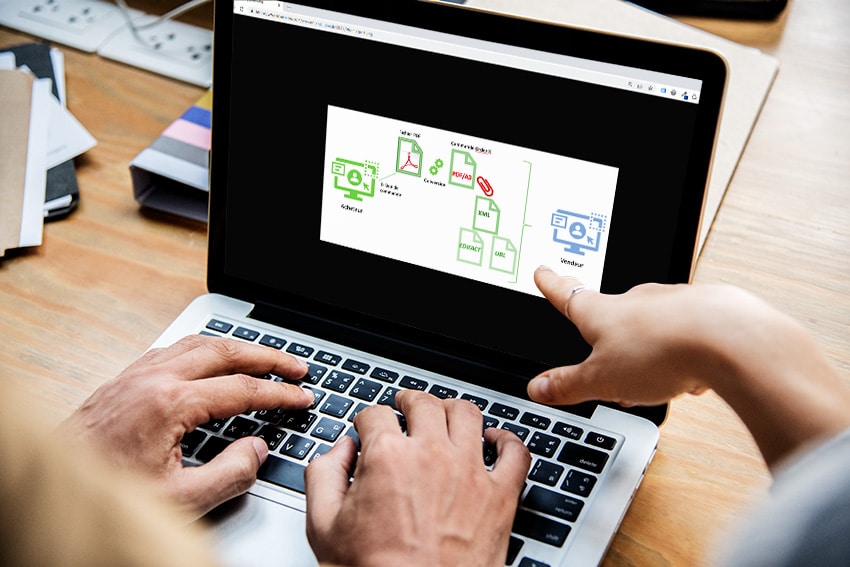ORDER-X : Setting a common standard for electronic orders
19 June 2023
19 June 2023

Order-X accelerates the transition to electronic ordering. Indeed, the widespread use of electronic order processing between companies requires the implementation of a common standard. A simple standard, accessible to all companies, from the smallest to the largest, is the objective of the Order-X standard.
In this article, find out more about the Order-X standard.
Order-X is a standard developed jointly by FNFE-MPE (Forum National de la Facture Electronique et des Marchés Publics Electroniques) and FeRD (Forum elektronische Rechnung Deutschland).
Order-X is based on the same model as Factur-X electronic invoices. In other words, an electronic order model in a hybrid format, available in different data profiles.
Order-X is a hybrid or mixed format. In other words, it’s a digital file that can be read by both man and machine.

An Order-X command is represented by :
The PDF/A3 file is the visual representation of the order. The A3 format enables it to encapsulate files.
The XML file embedded in the PDF contains the order data, structured according to the SCRDM (Supply Chain Reference Data Model) specifications drawn up by UN/CEFACT.
In this way, the Order-X order received electronically can be processed either manually, by re-entering information from the PDF. Or processed automatically by integrating the data contained in the XML.
A hierarchy of three data profiles covers business needs from the most basic to the most complex. These three profiles are consistent with the Factur-X profiles.
BASIC is designed for simple supply chains. It corresponds to a standard, single-delivery order process, and contains all the basic information needed to automate order processing :
COMFORT supplements the BASIC profile for multiple deliveries with additional information :
EXTENDED allows complex logistics processes to be taken into account : multiple delivery or collection points, product-specific allotment or warehousing conditions, minimum and maximum quantities, VAT allocation, etc.
EXTENDED is equivalent to the COMFORT profile, with additional data fields at the initiative of business partners to meet specific logistics requirements.
As with Factur-X, electronic ordering or e-ordering is initiated by the issuer of the order.
To create an electronic purchase order in Order-X format, you don’t need to change ERP. Simply continue to print purchase orders in PDF format.
The PDF file is converted to PDF/A3, in which an XML file named order-x.xml is embedded. The XML contains all the data required for the BASIC, COMFORT or EXTENDED profile.
For suppliers who accept orders in structured formats other than XML, it is also possible to integrate PDF/A3 :

To cover all stages of an order process, the Order-X format offers three messages :
This is the buyer’s initial order to the seller.
Message from the seller to the buyer in which the seller can :
Message from the buyer to the supplier to modify the initial order. This message allows the buyer to :
An ORDER_CHANGE message can be sent before an ORDER_RESPONSE message is received, to modify the initial order. Several ORDER_CHANGE messages can be exchanged following an ORDER.

As with Factur-X, to make the Order-X standard accessible to all companies. Documentation and technical specifications are publicly available on the FNFE-MPE website.
The Order-X format has a number of advantages for small and medium-sized businesses, enabling them to send their orders electronically.
Order-X is based on the UN/CEFACT SCRDM (Supply Chain Reference Data Model). This enables cross-border and cross-sector trade. Electronic order data in Order-X format will always be readable and interpretable.
The hybrid format with PDF/A3 allows structured representations of the order in EDIFACT or UBL format to be included in the order message. This makes it possible to send Order-X orders via EDI networks.
And last but not least, Order-X :
With the mandatory introduction of electronic invoicing for all companies on July 1, 2024, Factur-X is set to become the standard for business-to-business electronic invoicing. With Order-X, the same operating principles as Factur-X are replicated for sending supplier orders electronically.
Tenor naturally offers EDI solutions compatible with the Order-X standard. These allow you to send your orders automatically, directly from your ERP system. Contact our teams to validate your needs and launch your project today !